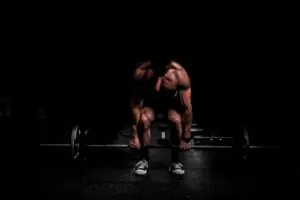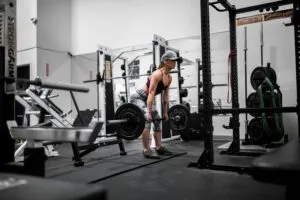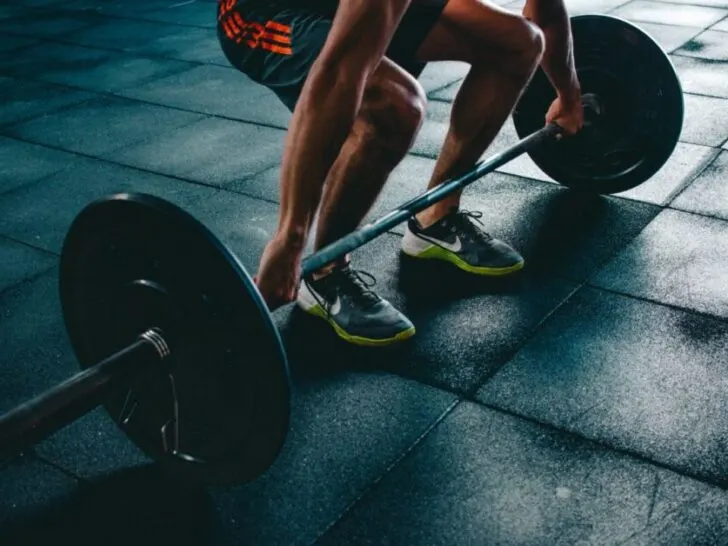Some of the links in this post are affiliate links. This means if you click on the link and purchase the item, we will receive an affiliate commission from the vendor at no extra cost to you. These business relationships allow us to keep bringing you great EatMoveHack content. All opinions remain our own.
The deadlift is a classic compound exercise that’s loved by many in the fitness community. Nevertheless, the heavy weight and sheer strength needed for the exercise poses a large threat of injury if done incorrectly. We all know the importance of form and we hear it all day every day. However, do you know what to look for in proper deadlift form? Learning a few key deadlift cues can help keep you safer while learning this compound exercise.
Why are Deadlifts so Great?
We all know deadlifts are a great compound exercise but why exactly?
Well because it’s a compound exercise deadlifts engage almost every muscle in the body. Your arms, forearms, and grip strength help to hold the bar stable and in place throughout the lift. Additionally, your core and back keep your body tight and stable while also securing your spine.
Did you know an exercise that uses multiple muscles at once generates a higher level of fat loss and burning of calories? This is due to the factor that a lot more energy is required to perform these types of exercises.
Another (not so) fun fact is that the leading cause of disability in Americans of all ages is back pain. Luckily, deadlifts are great at strengthening your posterior chain and back muscles in general. This is one of the best ways to delay or prevent back pain that can be caused by weakening back muscles.
Proper Deadlift Form
So if we know that form is the most important factor in safe deadlifting what does this look like?
Lets first go through the various steps:
- Stand with your feet shoulder-width apart just under the bar
- Grab the bar just further than shoulder-width apart with your preferred grip
- Bend your knees forward until your shins just barely touch the bar
- Straighten your lower back while keeping your chest and shoulders up
- Breath in before powering through with your legs and lifting the bar off the ground
- Pause at the top by locking your hips and knees
- Return to the ground by moving your hips back and simultaneously bending your knees
Now, this is obviously a straightforward explanation, but it’s a great starting point.
As a beginner, you should start by just practicing your form. The best way for anyone to improve the amount they can deadlift is by improving their technique. Only once you are comfortable with the mechanics of the exercise you can slowly start adding some weight.
Deadlifting Cues
 Below are some great cues you can use as a beginner to help improve your form:
Below are some great cues you can use as a beginner to help improve your form:
– When looking from the side, the path of the bar should be in a vertical straight line
– The barbell should come back to the floor and rest over the middle of your foot after every rep
– Your feet should be fully planted on the floor at a 15-20 degree angle outwards
– Grip is personal preference but your thumbs should be around the bar helping with grip strength
– When looking at your arms they should be slightly inclined from a side view but vertical from a front view
– Your elbows should never be bent, always straight and locked out
– You should keep your chest up to avoid rounding in the back
– Your lower back should have a natural inward curve and no excessive outward rounding
– Shoulder blades should be above the bar and relaxed – don’t squeeze them
– Your hips should always stay above parallel. Do not squat or break parallel during a deadlift
– You should be taking a deep breath before the lift, holding it at the top, then exhaling at the bottom again
– Pulling the bar off the ground should be a smooth fluid motion. Don’t jerk the bar from the starting position
– On the way down, bring your hips back first then bend your legs while bringing the bar down to the bottom
– Don’t bounce the bar off the ground in-between reps. Rest for a second with a slow controlled breath
These are some great pointers that will help you lift like a pro!
Common Deadlift Problems
Bar Scraping
One of the main problems people are usually running into is excessive damage to their shins. The scraping of the bar along the shins is a common (and uncomfortable) problem that turns many people away from deadlifts instantly.
Now, something high and padded like these deadlifting socks might be enough protection from the bar, however, if the problem persists there are a few simple ways you can easily fix this further.
The first and most common reason for this problem is pulling the bar back and not up. Remember our tip from earlier? From a side view, you should be pulling the bar directly vertical.
If you are having troubles with this then you might be rocking back or lifting your chest and shoulders too soon during the exercise. Remind them that proper form is keeping your chest up and over the bar until it is lifted off the ground.
A second common mistake in beginners that may cause damage to their shins is starting with their hips too low. This is an issue because dropping your hips low will force your knee to be pushed forward.
If this is the case the knees may be in the way of the bar during the exercise, causing it to scrape on its path upwards.
Fixing this is pretty simple, just bring your butt up and never break below parallel.
If all else fails you can use some shin protecting equipment. One that I have found success with is a deadlift shin guard. These are great because they add a larger protective layer between the bar and shin without being too bulky or intrusive.
Rounded and Arched Back
 Another common mistake I see beginners making is having a rounded or arched back. As stated by Dr. Stuart McGill rounding of the back can easily lead to spinal disc herniation and bulges. This is something you defiantly don’t want happening.
Another common mistake I see beginners making is having a rounded or arched back. As stated by Dr. Stuart McGill rounding of the back can easily lead to spinal disc herniation and bulges. This is something you defiantly don’t want happening.
So how do we fix rounding in the back? Tension and a proper set up is the key to this. Engaging your lats more is a great way to provide more spinal stability and prevent this rounding.
Many people think pulling the shoulders back is the proper way to achieve this back tightness. This is not the case as it will actually increase the distance the bar has to travel.
Instead, I usually suggest that you take the “slack” out of the bar before pulling it off the ground. This will help to fully engage the back and lats from the start. Never forget to keep that chest up and over the bar!
Wrapping Up
Deadlifts are a great exercise for any beginner. However, doing them properly is an important factor to keep in mind. We always suggest perfecting proper deadlift form before even thinking about putting on weight.
Nevertheless, if you follow our deadlift cues you should have no problems perfecting your proper deadlift form and lifting heavier weight in no time!
Check out some of our other articles to keep you moving forward:

